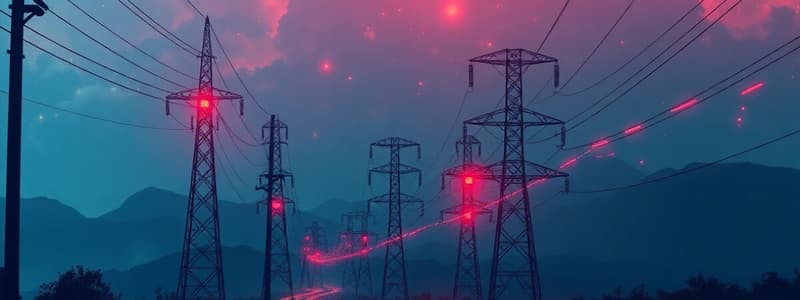Podcast
Questions and Answers
What primarily determines the resistance of steel rails?
What primarily determines the resistance of steel rails?
- Resistance of the joints between rails (correct)
- Temperature of the rails
- Type of steel used
- Length of the rails
What happens to the screening factor if the track is well maintained?
What happens to the screening factor if the track is well maintained?
- Becomes greater than 0.7
- Increases to 0.8
- Becomes less than 0.6 (correct)
- Remains constant at 0.6
Which protective measure is used to limit the longitudinal build-up of emf in telecommunication circuits?
Which protective measure is used to limit the longitudinal build-up of emf in telecommunication circuits?
- Increasing cable length
- Insertion of isolating transformers (correct)
- Adding extra voltage regulators
- Use of copper wires
What is a consequence of using open-wire aerial communication lines in relation to induced voltages?
What is a consequence of using open-wire aerial communication lines in relation to induced voltages?
What should be the break down test voltage of a cable to withstand voltages induced by a short circuit?
What should be the break down test voltage of a cable to withstand voltages induced by a short circuit?
What is the rms value permissible for cables tested with dc after installation?
What is the rms value permissible for cables tested with dc after installation?
If no breakdown tests are performed, what is the acceptable rms value range for cables tested at the factory?
If no breakdown tests are performed, what is the acceptable rms value range for cables tested at the factory?
Under what condition may higher induced voltages be permissible on cable conductors?
Under what condition may higher induced voltages be permissible on cable conductors?
What is the maximum permissible capacitive coupling current through a conductor-to-earth contact?
What is the maximum permissible capacitive coupling current through a conductor-to-earth contact?
What types of coupling can occur between two circuits?
What types of coupling can occur between two circuits?
What precaution should be ensured when working on cables carrying significant telecommunications voltages?
What precaution should be ensured when working on cables carrying significant telecommunications voltages?
What must isolating transformers and other line apparatus achieve regarding dielectric strength?
What must isolating transformers and other line apparatus achieve regarding dielectric strength?
What does the formula for induced emf in an overhead line primarily depend on?
What does the formula for induced emf in an overhead line primarily depend on?
What is the role of the reduction factor Kr in the context of induced emf?
What is the role of the reduction factor Kr in the context of induced emf?
Which reduction factor accounts for the induced currents in a metal sheathed cable?
Which reduction factor accounts for the induced currents in a metal sheathed cable?
How does the mutual inductance M vary?
How does the mutual inductance M vary?
Under what conditions does the reduction factor Kc improve?
Under what conditions does the reduction factor Kc improve?
What is the purpose of earthed conductors such as cable sheaths and metal pipes?
What is the purpose of earthed conductors such as cable sheaths and metal pipes?
What does the parameter 'a' represent in the formula for mutual inductance M?
What does the parameter 'a' represent in the formula for mutual inductance M?
Which factor can lead to an appreciable reduction in electromagnetic interference?
Which factor can lead to an appreciable reduction in electromagnetic interference?
What impact does the total induced current flowing in the rails have on the induced current of the overhead line?
What impact does the total induced current flowing in the rails have on the induced current of the overhead line?
In terms of interference reduction, what is the effect of the catenary current?
In terms of interference reduction, what is the effect of the catenary current?
What effect does increasing the mutual inductance between the sheath and wires have on screening?
What effect does increasing the mutual inductance between the sheath and wires have on screening?
What is the screening factor for a lead sheathed cable?
What is the screening factor for a lead sheathed cable?
How does the presence of metal work connected to earth near the track affect cable screening?
How does the presence of metal work connected to earth near the track affect cable screening?
What is a characteristic of the rails as conductors in terms of current behavior?
What is a characteristic of the rails as conductors in terms of current behavior?
In what scenario will rail current divide equally between feeding and loading points?
In what scenario will rail current divide equally between feeding and loading points?
What happens to part of the current in the rails as it moves away from the feeding point?
What happens to part of the current in the rails as it moves away from the feeding point?
How does the load current interact with the rails in practice?
How does the load current interact with the rails in practice?
What phenomenon causes an induced voltage in the rails?
What phenomenon causes an induced voltage in the rails?
What effect does steel tape armouring have on the screening factor?
What effect does steel tape armouring have on the screening factor?
What is the formula for calculating the induced voltage to earth on overhead bare conductors?
What is the formula for calculating the induced voltage to earth on overhead bare conductors?
Which of the following factors does NOT affect the current to earth from an earthed line?
Which of the following factors does NOT affect the current to earth from an earthed line?
What happens to the induced voltage as the horizontal spacing between the contact wire and the overhead conductor increases?
What happens to the induced voltage as the horizontal spacing between the contact wire and the overhead conductor increases?
When bare conductors are earthed through a person's body, what is the resulting discharge current proportional to?
When bare conductors are earthed through a person's body, what is the resulting discharge current proportional to?
What is the approximate induced voltage at a separation of 6 meters from a 25 kV contact wire?
What is the approximate induced voltage at a separation of 6 meters from a 25 kV contact wire?
According to the properties of induced voltage, which statement is correct?
According to the properties of induced voltage, which statement is correct?
What is the breakdown voltage of the spark gaps in telephone circuits mentioned in the content?
What is the breakdown voltage of the spark gaps in telephone circuits mentioned in the content?
Which method is used to take the effect of earth into account?
Which method is used to take the effect of earth into account?
What condition leads to a continuous discharge across spark gaps?
What condition leads to a continuous discharge across spark gaps?
What is the permissible continuous induced voltage limit recommended for safe operation?
What is the permissible continuous induced voltage limit recommended for safe operation?
Under what condition can the permissible voltage limit be raised to 150 volts rms?
Under what condition can the permissible voltage limit be raised to 150 volts rms?
What is the maximum permissible induced voltage during a fault on a nearby inducing line that meets standard technical specifications?
What is the maximum permissible induced voltage during a fault on a nearby inducing line that meets standard technical specifications?
What must be done when the induced voltage exceeds 60 volts rms?
What must be done when the induced voltage exceeds 60 volts rms?
What is the primary precaution to protect operators from induced voltages?
What is the primary precaution to protect operators from induced voltages?
What is the permissible peak voltage during a contact to earth of one wire of a nearby electrified railway line?
What is the permissible peak voltage during a contact to earth of one wire of a nearby electrified railway line?
What method is suggested for reducing noise interference in overhead communication circuits?
What method is suggested for reducing noise interference in overhead communication circuits?
Which protective measure is recommended when working near areas with voltage exceeding 60 volts rms?
Which protective measure is recommended when working near areas with voltage exceeding 60 volts rms?
What is the permissible induced voltage on cable conductors during a fault on a high-reliability power line?
What is the permissible induced voltage on cable conductors during a fault on a high-reliability power line?
What aspect impacts the effectiveness of periodic transposition in reducing induced emf?
What aspect impacts the effectiveness of periodic transposition in reducing induced emf?
How can the magnetic coupling between sheath and conductors be increased?
How can the magnetic coupling between sheath and conductors be increased?
What is the approximate screening factor achievable with well-designed cable circuits near electrified sections?
What is the approximate screening factor achievable with well-designed cable circuits near electrified sections?
What is the recommended minimum separation between a 25 kV contact wire and a communication line to limit induced voltage to 300 Volts?
What is the recommended minimum separation between a 25 kV contact wire and a communication line to limit induced voltage to 300 Volts?
What is the effect of the reduction factor Kr on the induced emf in an overhead line?
What is the effect of the reduction factor Kr on the induced emf in an overhead line?
What happens to the induced voltage when the separation between the inducing line and the receiving line is increased to 40 m?
What happens to the induced voltage when the separation between the inducing line and the receiving line is increased to 40 m?
Which of the following factors contributes to the definition of mutual inductance M per unit length?
Which of the following factors contributes to the definition of mutual inductance M per unit length?
Which factor is mentioned as reducing the effective height of overhead conductors?
Which factor is mentioned as reducing the effective height of overhead conductors?
What impacts the reduction factor Kc when evaluating induced emf between a cable conductor and its sheath?
What impacts the reduction factor Kc when evaluating induced emf between a cable conductor and its sheath?
Which parameter is NOT associated with the screening effect in the context of earthed conductors?
Which parameter is NOT associated with the screening effect in the context of earthed conductors?
What effect does the roughness of earth's surface have on electric capacitances in overhead lines?
What effect does the roughness of earth's surface have on electric capacitances in overhead lines?
How does the frequency of the inducing current affect the reduction factor Kc?
How does the frequency of the inducing current affect the reduction factor Kc?
In practice, what is the relationship between calculated values of electric induced voltages and measured values?
In practice, what is the relationship between calculated values of electric induced voltages and measured values?
What does the parameter 's' represent in the context of mutual inductance M?
What does the parameter 's' represent in the context of mutual inductance M?
How does increasing mutual capacitance between conductors affect induced voltages?
How does increasing mutual capacitance between conductors affect induced voltages?
What is the relationship between the total induced current flowing in the rails and the catenary current according to the content?
What is the relationship between the total induced current flowing in the rails and the catenary current according to the content?
What formula provides a more conservative approach for calculating minimum separation distance in overhead lines?
What formula provides a more conservative approach for calculating minimum separation distance in overhead lines?
What impact do high harmonics have on electric induction in overhead lines?
What impact do high harmonics have on electric induction in overhead lines?
When does Kc tend to be smaller under heavy inductive conditions?
When does Kc tend to be smaller under heavy inductive conditions?
What can be concluded about the screening effects of earthed conductors?
What can be concluded about the screening effects of earthed conductors?
Which of the following conditions is most likely to be fulfilled in practical applications of these overhead lines?
Which of the following conditions is most likely to be fulfilled in practical applications of these overhead lines?
In what form is the function M, representing mutual inductance, expressed?
In what form is the function M, representing mutual inductance, expressed?
How does increasing mutual inductance between sheath and wires affect the screening?
How does increasing mutual inductance between sheath and wires affect the screening?
What happens to the rail current after a few kilometers?
What happens to the rail current after a few kilometers?
Under what circumstances does the return current split equally at feeding and loading points?
Under what circumstances does the return current split equally at feeding and loading points?
What effect does having several cables buried in the same trench have on screening?
What effect does having several cables buried in the same trench have on screening?
How is the induced voltage in the rails calculated?
How is the induced voltage in the rails calculated?
What is the effect of steel tape armoring on the screening factor?
What is the effect of steel tape armoring on the screening factor?
Which characteristic is NOT associated with the rails as conductors?
Which characteristic is NOT associated with the rails as conductors?
What causes the induced voltage in the rails from the overhead line?
What causes the induced voltage in the rails from the overhead line?
What is the primary consequence of the rail current's proximity to the earth?
What is the primary consequence of the rail current's proximity to the earth?
Flashcards
Permissible induced voltage on cables
Permissible induced voltage on cables
The maximum acceptable voltage that can be induced into cable conductors.
Cable breakdown strength test
Cable breakdown strength test
Testing the ability of cables to withstand voltage without breaking down.
Permissible capacitively-coupled current
Permissible capacitively-coupled current
The maximum allowable current flow through a contact between a cable conductor and the earth or other metal.
Conduction coupling
Conduction coupling
Signup and view all the flashcards
Electrostatic induction
Electrostatic induction
Signup and view all the flashcards
Electromagnetic induction
Electromagnetic induction
Signup and view all the flashcards
10 mA current
10 mA current
Signup and view all the flashcards
Induced voltage on parallel lines
Induced voltage on parallel lines
Signup and view all the flashcards
Charging current (earthed line)
Charging current (earthed line)
Signup and view all the flashcards
Electrostatic image (earth effect)
Electrostatic image (earth effect)
Signup and view all the flashcards
Formula for induced voltage
Formula for induced voltage
Signup and view all the flashcards
Induced voltage and spacing
Induced voltage and spacing
Signup and view all the flashcards
Spark gap breakdown voltage
Spark gap breakdown voltage
Signup and view all the flashcards
Induced voltage threshold
Induced voltage threshold
Signup and view all the flashcards
Earth capacitance
Earth capacitance
Signup and view all the flashcards
Mutual capacitance
Mutual capacitance
Signup and view all the flashcards
Induced EMF in overhead lines
Induced EMF in overhead lines
Signup and view all the flashcards
Formula for induced EMF
Formula for induced EMF
Signup and view all the flashcards
Mutual Inductance (M)
Mutual Inductance (M)
Signup and view all the flashcards
Kr (rail current reduction factor)
Kr (rail current reduction factor)
Signup and view all the flashcards
Kc (cable reduction factor)
Kc (cable reduction factor)
Signup and view all the flashcards
Km (metallic pipework reduction factor)
Km (metallic pipework reduction factor)
Signup and view all the flashcards
Screening effect
Screening effect
Signup and view all the flashcards
Mutual Inductance (M) dependence
Mutual Inductance (M) dependence
Signup and view all the flashcards
Approximating Kt
Approximating Kt
Signup and view all the flashcards
Kc dependence on frequency
Kc dependence on frequency
Signup and view all the flashcards
Cable Sheath Screening
Cable Sheath Screening
Signup and view all the flashcards
Sheath Resistance Impact
Sheath Resistance Impact
Signup and view all the flashcards
Mutual Inductance Role
Mutual Inductance Role
Signup and view all the flashcards
Aluminium vs. Lead
Aluminium vs. Lead
Signup and view all the flashcards
Steel Tape Armouring Effect
Steel Tape Armouring Effect
Signup and view all the flashcards
Rail Current Properties
Rail Current Properties
Signup and view all the flashcards
Rail Current Attenuation
Rail Current Attenuation
Signup and view all the flashcards
Rail Current Distribution
Rail Current Distribution
Signup and view all the flashcards
Return Current Path
Return Current Path
Signup and view all the flashcards
Induced Voltage in Rails
Induced Voltage in Rails
Signup and view all the flashcards
Screening Factor
Screening Factor
Signup and view all the flashcards
Fish Plate
Fish Plate
Signup and view all the flashcards
Coherer Effect
Coherer Effect
Signup and view all the flashcards
Protective Measures
Protective Measures
Signup and view all the flashcards
CCIT Directives
CCIT Directives
Signup and view all the flashcards
Permissible Induced Voltage (Normal Operation)
Permissible Induced Voltage (Normal Operation)
Signup and view all the flashcards
Permissible Induced Voltage (Fault)
Permissible Induced Voltage (Fault)
Signup and view all the flashcards
Earthed Metallic Sheath
Earthed Metallic Sheath
Signup and view all the flashcards
Isolating Transformers
Isolating Transformers
Signup and view all the flashcards
Lightning Protectors
Lightning Protectors
Signup and view all the flashcards
Parallelism Limit
Parallelism Limit
Signup and view all the flashcards
Separation and Induced Voltage
Separation and Induced Voltage
Signup and view all the flashcards
CCITT Formula
CCITT Formula
Signup and view all the flashcards
Oblique Exposure
Oblique Exposure
Signup and view all the flashcards
Ideal vs. Real Conditions
Ideal vs. Real Conditions
Signup and view all the flashcards
Capacitance Effects
Capacitance Effects
Signup and view all the flashcards
Measured vs. Calculated
Measured vs. Calculated
Signup and view all the flashcards
Harmonic Impact
Harmonic Impact
Signup and view all the flashcards
Noise in communication lines
Noise in communication lines
Signup and view all the flashcards
Transposition of conductors
Transposition of conductors
Signup and view all the flashcards
Rail current reduction factor (Kr)
Rail current reduction factor (Kr)
Signup and view all the flashcards
Study Notes
Interference Problems with 25 kV AC Traction
- Interference to line-side cables from an adjacent AC traction system is a specific case of interference between power and telecommunication lines.
- Interference can be caused by electric or magnetic fields.
- Strong coupling between power and communication circuits is not necessary for interference to occur.
- Power used in transmission lines varies depending on the voltage.
- 400 kV lines use 109 W.
- 132 kV lines use 108 W.
- 33 kV lines use 5 x 106 W.
- 11 kV lines use 106 W.
- 400/240 V mains use 104 W.
- Telephone lines have significantly lower power levels.
- Sending end: 10−3 W.
- Receiving end: 10−5 W.
- Power systems prioritize high efficiency, while telecommunication systems prioritize clear signal transmission.
- Interference in telecommunications can range from minor noise to significant signal distortion.
- Disturbance refers to perceptible noise.
- Danger is more critical and can cause equipment damage or risk to human life.
- Tolerable levels of interference depend on the specific communication system and operating conditions.
CCIT Directives
- The International Telegraph and Telephone Consultative Committee (CCITT) provides permissible induced voltage limits.
- Permissible continuous induced voltage is limited to 60 volts rms for screened or unscreened cables and open wire lines.
- Under specific conditions (e.g., difficult work operations), the limit may increase to 150 volts rms.
- Special precautions must be taken in these cases, including worker training and warning markings.
Permissible Voltage Levels During Fault
- During faults in nearby power lines, maximum permissible voltage levels on telecom lines are:
- 430 volts rms for power lines meeting standard construction codes.
- 650 volts rms for high-reliability power lines.
- 1000 volts peak for contact with earth on DC or electrified railways.
- Increased permissible voltage limits may apply to cables with earthed sheaths or lightning arrestors.
- For cables tested for breakdown strength
- DC: 60% of the test voltage
- AC: 85% of the test voltage
Conductive and Capacitive Coupling
- Conductive coupling occurs when circuits share a common branch.
- Capacitive coupling results in current flow through a contact between a conductor and earth or other metal. Up to 10 mA is considered permissible under this type of coupling.
Electrostatic Induction
- Electric fields induce voltage in parallel lines, with voltage inversely proportional to the separation distance.
Electromagnetic Induction
- The induced emf in an overhead line or cable parallel to an electrified railway depends on a number of factors:
- Mutual inductance per unit length
- Distance between the lines
- Supply frequency
- Catenary current
- Reduction factors (Kr, Kc, Km) for rail current, cable type, and the presence of earthed conductors or metallic pipework with high induced current.
Mutual Impedance M per Kilometer
- The mutual impedance and separation distance are expressed in a graph (Fig. 8.3).
Rail Currents
- Rail current is diverted into the earth at greater distances and higher frequencies due to the high attenuation and leakance of the rails.
- Rail currents often return to their origin points via alternative paths, including earth or other conductors.
Protective Measures
- Protective measures can be implemented in the low-current communication or at the source (the power supply).
- Protection involves use of isolating transformers, balancing circuits, and increasing signal-to-noise ratios.
- Methods for limiting the long-term effects from induced currents include voltage arrestors, protectors, and fuses.
- DC circuits and those containing operators should be replaced with AC or impulse circuits where possible, and safety procedures must be observed.
- Cabling overhead communication circuits or other measures can reduce interference.
- Screening is important in improving shielding effects.
- Steel tape armouring enhances magnetic screening.
Suppression of Interference at Source
- Booster transformers with a 1:1.1 ratio can significantly reduce interference.
- The booster transformer's secondary winding is connected to the rails in some systems to increase the current (e.g., to supply to rail circuits), decreasing noise on the telecom circuits.
- Additional limitations may occur if there is high impedance on the circuit, or harmonic components in the currents.
Booster Transformer System with Return Conductor.
- The return conductor method significantly reduces inductive interference.
- Booster transformer primaries are connected in series with contact wires, designed to withstand high voltages & endure any mechanical or thermal stresses.
AT System
- This 2x25kV overhead transmission and track alternating current (AT) system suppresses induction.
- Transformers (ATs) are placed along the track with the centre tap used for return current to avoid interference to the power feeding network.
Studying That Suits You
Use AI to generate personalized quizzes and flashcards to suit your learning preferences.




